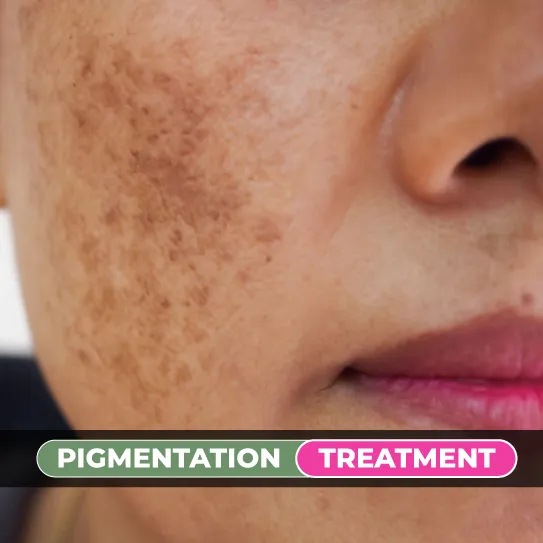
Hyperpigmentation Treatment
Pigmentation Causes & TreatmentsWant clear skin without hyperpigmentation? Get it with Dot Clinics skin specialists! Your dark spots making you wonder if they will ever leave? It may be age spots, melasma or skin inflammation but you can have clear skin again.
As one of the leading clinics in Multan, Pakistan, Dot Clinics has the best pigmentation treatment available, with a team of highly experienced skin specialists on board.
Pigmentation treatment
Hyperpigmentation treatment works to lighten dark spots, prevent patches and uneven skin tone on your face and body by excess melanin. This treatment helps brighten and rejuvenate your skin’s natural glow.
- Various treatment options, including PRP, microneedling, and chemical peels, are used to help you get rid of your hyperpigmentation.
- From your very first consultation to the moment you walk out with beautiful, clear skin, we offer a transparent experience.
Hyperpigmentation Details

Why Pigmentation Happen?
To treat hyperpigmentation, first, our doctor needs to analyze the cause, since everyone's skin is different, so the cause for pigmentation. Common causes include:
- Sun Damage: This is one major cause. Regular exposure to sun (without sunscreen) around your face, neck and hands can cause pigmentation.
- Hormonal Changes: This is another major reason. Some specific health conditions, pregnancy, or hormonal treatments can also cause melasma.
- Age: Yes, as you age, your skin ages too, so your skin's defense weakens and can’t resist sun and injuries if you don’t take care of it and it gets darker.
- Inflammation: Some skin injuries, itching, or irritation can lead to hyperpigmentation.
- Harsh Skin Products: You might have been using skin creams or products with chemicals that is dangerous to your skin.
- Medications: There are certain medications which cause pigmentation in our body and our skin as a side effect.
- Genetics: Certain types of pigmentation might be inherited; someone in your family may have this problem
- Medical Conditions: Diseases like Addison's disease affect hormones and increase melanin which leads to dark patches.
Treatment of Hyperpigmentation
Your skin could be oily, dry, normal, or sensitive so we tailor our treatment accordingly after analyzing the cause and choosing your hyperpigmentation treatment for your face, body, or lips.
- PRP: Platelet-rich plasma (PRP) therapy transforms your skin and treats hyperpigmentation completely. We draw your blood, run it through a machine that separates the platelets, and then we inject them back into your skin. PRP is also the best acne hyperpigmentation treatment, as they will eliminate wrinkles, acne scars, and heal your skin quickly with low inflammation. It’s a good, comprehensive way to manage melasma.
- Microneedling: We make small punctures in the skin, in this procedure, which heals your skin from the inside. It begins to repair and increases the collagen production. New, healthy skin cells are being born, replacing pigmented ones — and this is how your dark spots go away. This treatment will also improve your skin tone and texture. This is one of the best treatments for hyperpigmentation on your body and face, and you start seeing the difference within weeks.
- Chemical Peels: Chemical peels are common for treating hyperpigmentation on dark skin. This procedure uses a chemical solution to exfoliate the top layer of your skin and reveal the healthy skin below. It refreshes your skin and lightens your complexion.
Hyperpigmentation Treatment Price
The exact cost depends on the treatment plan you choose. For example, one session of PRP costs 8300. Our team will inform you of the total cost based on your treatment plan before starting. Connect With Our Team Now!
